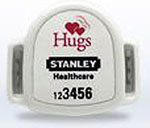Jul 09, 2013Stanley Healthcare has released a new version of its Hugs Infant Protection System, a tracking solution enabling hospitals to locate tags on babies, as well as identify when those tags may be leaving an authorized area, or come into contact with the wrong mother. Earlier versions of the system employed proprietary active radio frequency identification tags and required the installation of a network of proprietary readers, which often made covering areas beyond the obstetrics department prohibitively expensive. The latest generation leverages a hospital's existing Wi-Fi network, thereby allowing a customer to expand a system to an entire health-care facility or campus.
The new version of the Hugs Infant Protection System also includes temperature- and asset-tracking functionality, which can be used, for example, to ensure that breast milk is stored within a safe temperature range. All data is managed by Stanley Healthcare's AeroScout MobileView software—a software platform and graphical user interface for real-time location system (RTLS) solutions used with Stanley Healthcare's asset-management and patient-flow tracking solutions. (The previous version of Hugs did not come with the MobileView platform).
Hospitals already using the MobileView platform for tracking assets or monitoring temperatures within their facilities could simply add on the Hugs solution, says Diane Hosson, Stanley Healthcare's director of security solutions for acute and long-term care. Medical facilities already utilizing the older proprietary Hugs RFID technology could expand the system via their Wi-Fi network, and continue to use the proprietary RFID technology in areas where it was already installed.
The original Hugs solution, which the company acquired in 2008 (see Stanley Bolsters RFID Portfolio With VeriChip Subsidiary), is currently in use at more than 1,300 hospitals worldwide, Hosson reports. The tag, attached to a newborn's ankle via a strap, transmits its unique identifier once every 10 seconds to a network of RFID readers, while low-frequency (LF) exciters installed at doorways, elevators and other locations prompt the tag to transmit an alert signal. That alert can trigger the sounding of audible alarms or other actions, such as the closing and locking of doors, in order to ensure that a baby is not removed from a maternity ward or other authorized area. These same features are also present in the latest Wi-Fi version of Hugs.
The Hugs system also includes an optional component known as Kisses that employs LF RFID technology to ensure that an infant is not handed to the wrong mother. In this case, the mother wears a Kisses wristband with a built-in LF RFID transmitter that communicates with the infant's own Hugs tag. If the child's tag recognizes the mother's ID as correct, a lullaby is played. If it determines the match is incorrect, it sounds an audible alert and sends an alarm message to the server via an active RFID transmission.
Following its acquisition of AeroScout in 2012 (see Stanley Healthcare Solutions Acquires Wi-Fi-based RTLS Company AeroScout), Stanley Healthcare decided this year to offer the solution as part of its Wi-Fi-enabled technology products. This enables the system to be part of the MobileView platform used for tracking assets or temperatures.
"A facility-wide Wi-Fi based system is cost-effective because the infrastructure is already in place throughout the building," Hosson explains. The cost of traditional proprietary RFID systems, including the original Hugs solution, she says, "would be prohibitive to install throughout a facility. It would be unaffordable for most hospitals." More typically, users of the original Hugs system have installed the technology within a limited area, and thus lose visibility once a tag leaves that vicinity. According to Hosson, about 20 percent of infant abductions from hospitals take place outside of the obstetrics unit.
In addition, Hosson says, the Wi-Fi-based system allows users to store and manage data on the MobileView platform, providing greater flexibility. For example, if the hospital wants to track breast-milk temperatures to meet regulations and ensure that the milk is not unnecessarily discarded, the facility can install Stanley AeroScout T5 sensor tags in the coolers in which the milk is stored. The sensor tags would transmit their temperature readings to the MobileView software, which also manages infant location data.
Because the MobileView software is browser-based, nurses and other employees can access data regarding temperature readings or infant locations via mobile devices, such as tablets or laptops.
The new version of Hugs comes with "door controllers," updated LF exciters that now have built-in intelligence to lock a door in the event that they receive an LF transmission from an infant tag, even if the system has gone offline—for example, if the Wi-Fi network was not operating. MobileView also offers an "out-of-unit alert" that can simply send a message to the system's users when a baby has left the obstetrics unit. That child's location can then continue to be tracked as it moves throughout the hospital.
Additionally, the Hugs tags—both the old and new versions—come with a tamper-detection feature in which a tag signals an alert if its strap has been cut or tampered with. The software also triggers alerts if the tag's signal has not been detected for a specified period of time, or if its battery power is running low. What's more, the software can be programmed to allow a particular tag to leave the unit, but to issue an alert if the tag is not returned within an expected length of time.
Stanley Healthcare has begun installing the Wi-Fi-based version of Hugs at several hospitals. The firm is currently taking orders from other customers as well, with installations expected to be in place by fall of this year.


